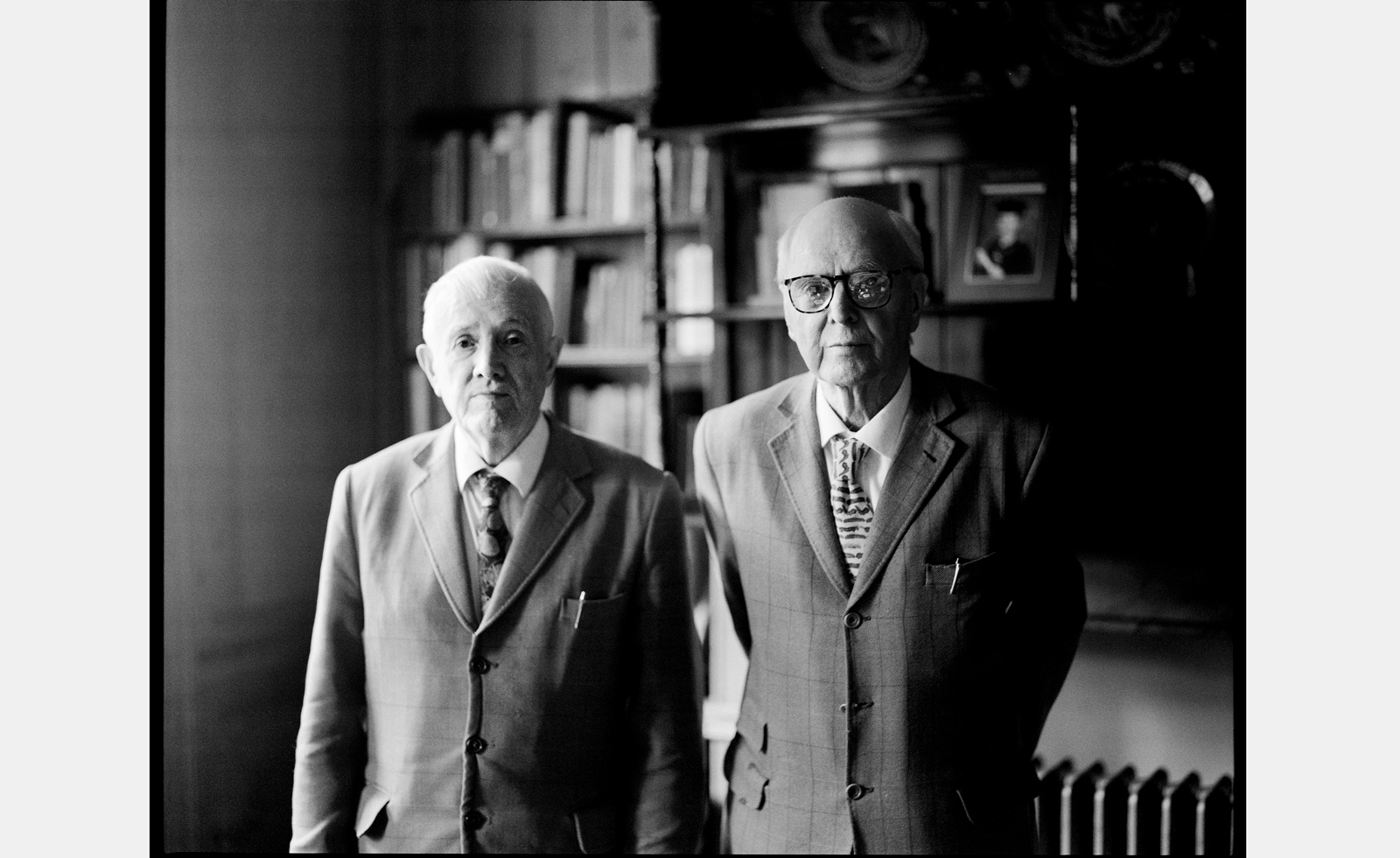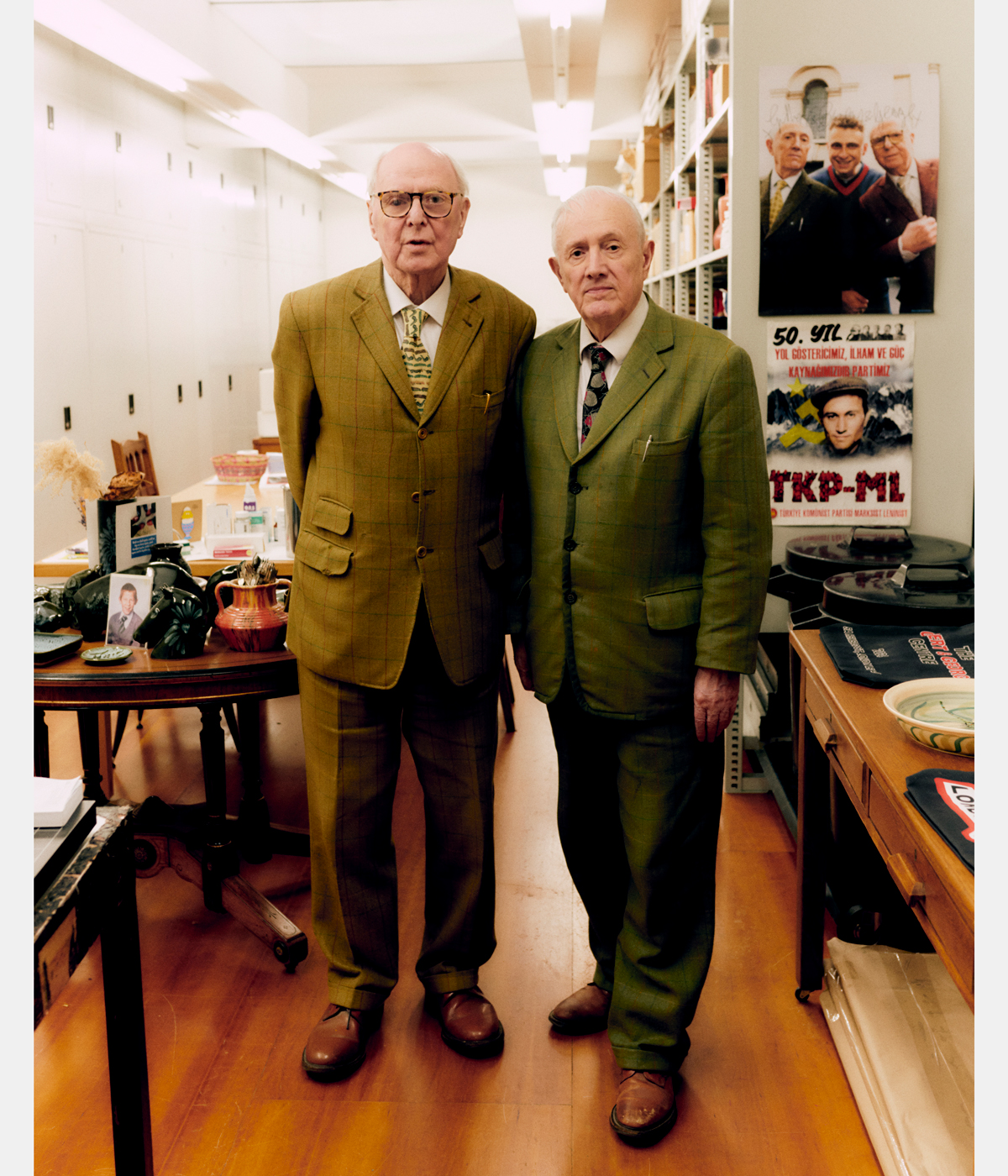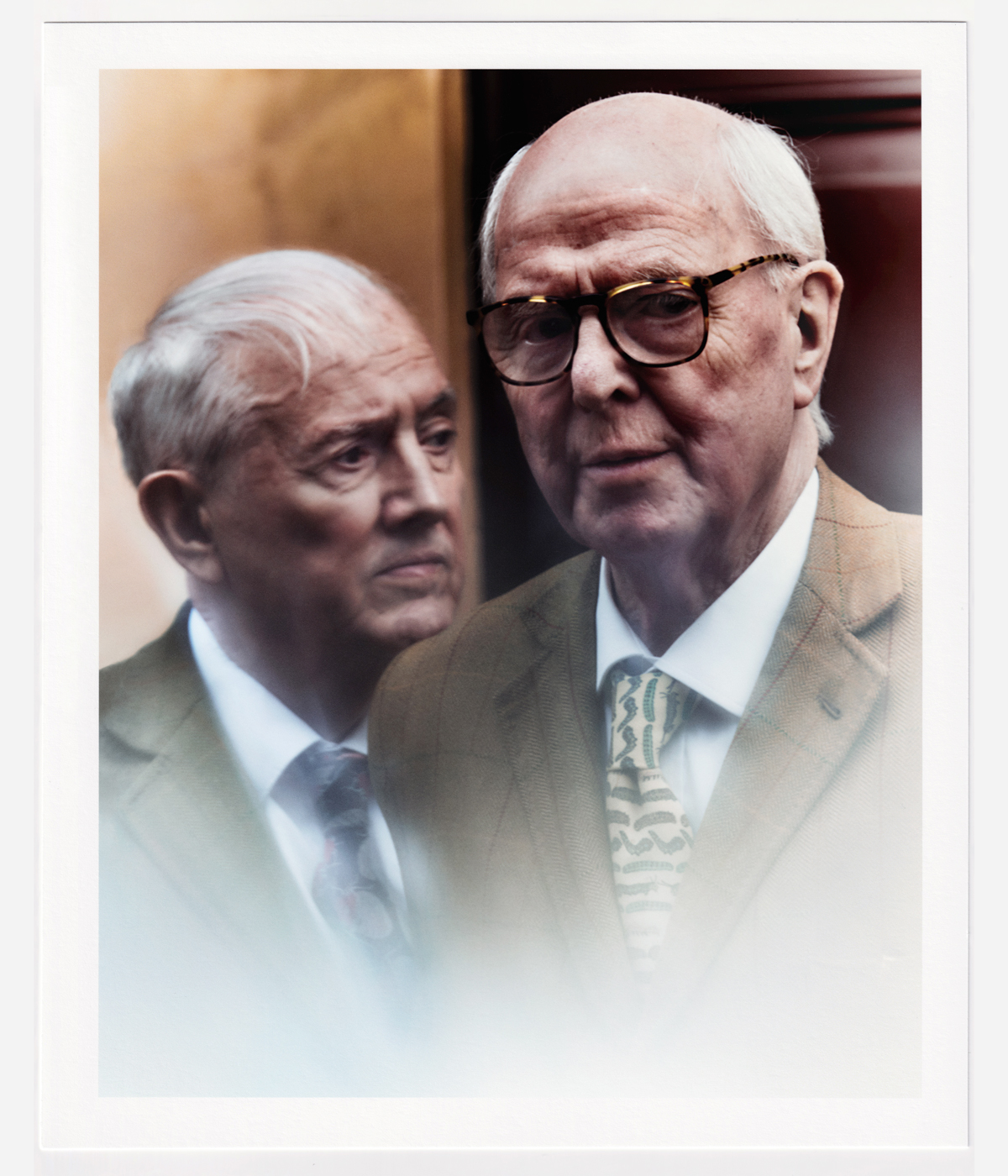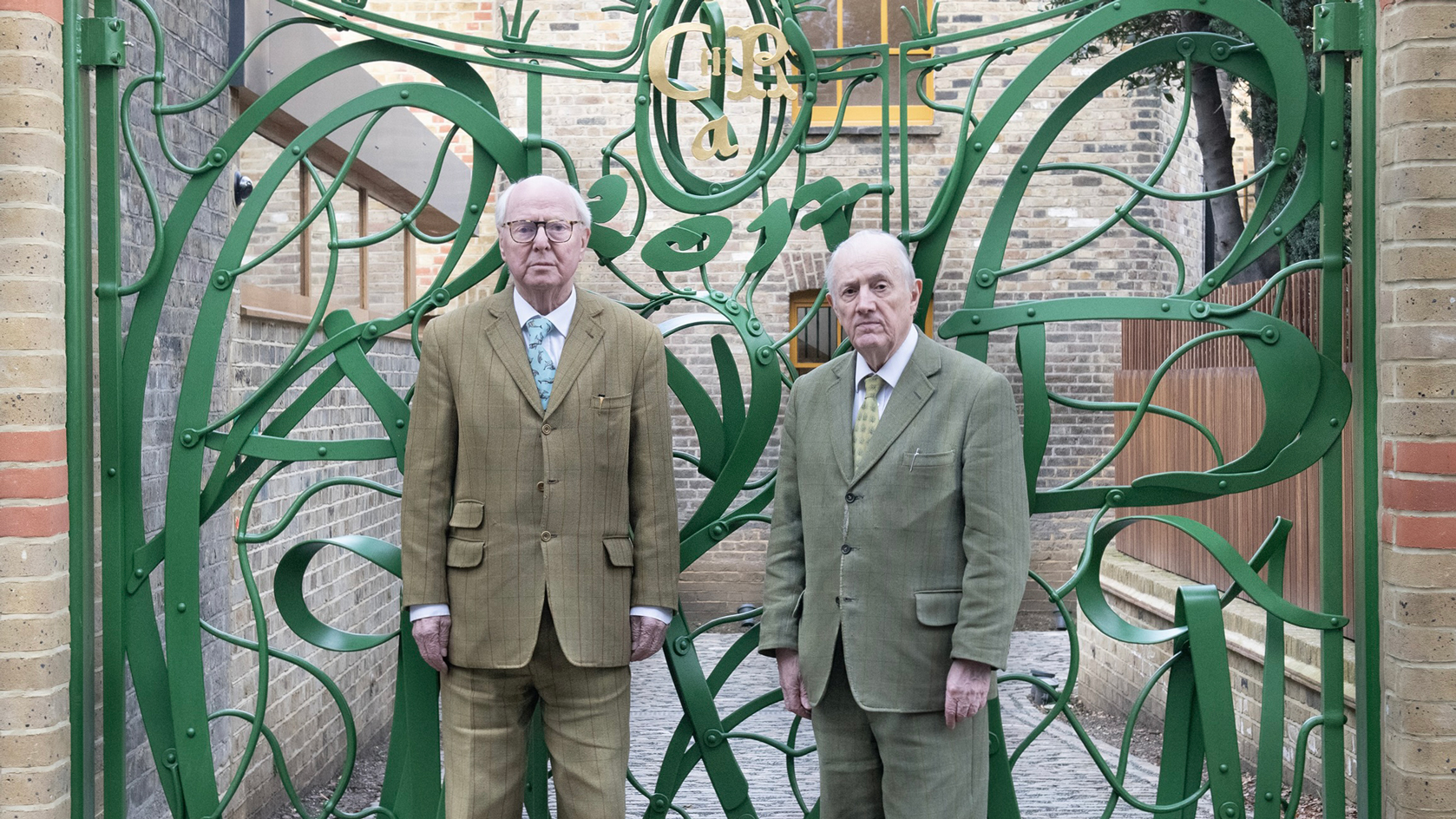Gilbert & George: ‘When people see us, that becomes part of the idea of two human beings as one artwork’
As their ‘London Pictures’ exhibition marks The Gilbert & George Centre’s first anniversary, the artists talk to Wallpaper* of their early practice, daily routine, and what next

Gilbert & George, first heralded for their performance piece The Singing Sculpture (1969), began their career with frequent appearances at parties, galleries, and art museums, acting as live sculptures, from the 1960s to the 1990s. In the variety of works they created, they erased the line between life and art. In the years since, the duo have focused on colourful, controversial pictures, often inspired by London’s East End. To date, they say, they have had more than 105 museum shows.
As their latest exhibition, ‘London Pictures’ runs at The Gilbert & George Centre, which they established in 2023, they remain, discreetly, as enthusiastic as ever. Wallpaper* joined Gilbert & George in conversation.
Gilbert & George: ‘We’re very excited about being alive’

Wallpaper*: You met in 1967 at art school. What was your practice like when you started out?
George: Looking back, we knew that you couldn't employ two people as an artist and you wouldn't get a grant for two people in that way. We wandered the streets of London rather than looking for grants.
Gilbert: We were very lucky because one day we were standing in a corner of a room with our heads (painted) gold, and a person comes up and says, ‘I'm Konrad Fischer. Do something with me in Dusseldorf.’
George: That was the leading modern art dealer in the world.

Gilbert & George, ‘London Pictures’, installation view at The Gilbert & George Centre, 2024. The London Pictures series, the largest group of pictures created by the artists, is comprised of 292 pictures, whose subject matter is taken from 3,712 newspaper posters, stolen by the artists over a number of of years
George: Within months of that, we were presenting The Singing Sculpture in Brussels, at a pop-up gallery, very unsuccessfully. Very few people came. At the end of the evening an old lady, she was much younger than we are now, came up. ‘My name is Ileana Sonnabend. I'm opening a gallery in New York and you must be the first exhibition.’ These two people, one picked us up for North America and one picked us up for Europe.
Wallpaper* Newsletter
Receive our daily digest of inspiration, escapism and design stories from around the world direct to your inbox.
Gilbert: In 1968, 1969 we started sending out these postal sculptures. It's like an artwork by post. We designed pieces of work in an envelope and sent it to special people. We used to have the addresses of 400 or 500 people.
George: Konrad Fischer gave us his address list.
Gilbert: An amazing success.

Gilbert & George, London, 2011, from ‘London Pictures’
W*: You have said, ‘Our whole life is one big sculpture.’ What are some things that you do to make your life a daily artwork?
Gilbert: First, I think, getting up.
W*: Just getting up, that's the most important thing.
George: We’ve always felt that we have a highly developed sense of purpose. If you’ve got a stall in the market you’ve got to have purpose: I’ve got the best shellfish.
Gilbert: When people see us, that becomes part of the idea of two human beings being one artwork.
W*: I've read that Kraftwerk was inspired by how you present yourself, how you’ve always worn nearly matching suits everywhere. Have you met Kraftwerk?
George: They did let us know that.
Gilbert: We never met them but yes, many people told us that.
W*: Do you ever listen to Kraftwerk’s music?
Gilbert: We don’t know what it is.
George: Music is the enemy.
W*: Is there any music you enjoy?
George: We don't have the equipment to listen to music.
Gilbert: We never listen to music.

W*: Never? That's very radical.
George: We don't like anything to take our brains into distraction.
Gilbert: We watch television at 6 o’clock for the news. That’s it.
George: That's why we go to the same restaurant every night and we never read the menu, because all of our friends are thinking which restaurant to go to tomorrow night. And when they get to the restaurant, they spend half an hour reading the menu before they have a meal. We try to keep operating, really concentrated.
W*: Focused on art?
George: Yes. On art and life. Death. Hope. Life. Fear. Sex.
Gilbert: Money.
George: Race.
Gilbert: Religion.
W*: What are you excited about right now?
George: We're excited because we're in the middle of creating a new group of pictures. We’re excited that we're doing [a] big Hayward show next year.
Gilbert: We’re very excited about being alive.
‘London Pictures’ is on view at The Gilbert & George Centre in London until the end of 2024. The artists’ 1974 book ‘Dark Shadow’ is back in print (available at Waterstones and Amazon)
Margo Fortuny is a writer and artist. Her work has appeared in Wallpaper*, Cabana, Dazed, Metal, Exit, and The New York Times. She has interviewed Nan Goldin, Damien Hirst, Alec Soth, Massive Attack, and a variety of artists. Margo enjoys painting, surprising people with kung fu moves, and all kinds of dancing.
-
 Tour the best contemporary tea houses around the world
Tour the best contemporary tea houses around the worldCelebrate the world’s most unique tea houses, from Melbourne to Stockholm, with a new book by Wallpaper’s Léa Teuscher
By Léa Teuscher
-
 ‘Humour is foundational’: artist Ella Kruglyanskaya on painting as a ‘highly questionable’ pursuit
‘Humour is foundational’: artist Ella Kruglyanskaya on painting as a ‘highly questionable’ pursuitElla Kruglyanskaya’s exhibition, ‘Shadows’ at Thomas Dane Gallery, is the first in a series of three this year, with openings in Basel and New York to follow
By Hannah Silver
-
 Australian bathhouse ‘About Time’ bridges softness and brutalism
Australian bathhouse ‘About Time’ bridges softness and brutalism‘About Time’, an Australian bathhouse designed by Goss Studio, balances brutalist architecture and the softness of natural patina in a Japanese-inspired wellness hub
By Ellie Stathaki
-
 Takashi Murakami and Ryan Murphy headline Wallpaper* November 2023
Takashi Murakami and Ryan Murphy headline Wallpaper* November 2023In the Wallpaper* November 2023 Art Special, discover Takashi Murakami’s pandemic-inspired creatures, producer Ryan Murphy’s Hollywood HQ, 20 years of Frieze and more, on newsstands today
By Sarah Douglas
-
 Gilbert & George on their new art centre in east London: ‘We all want to live forever, don’t we?’
Gilbert & George on their new art centre in east London: ‘We all want to live forever, don’t we?’As the Gilbert & George Centre prepares to open on 1 April 2023, we interview the artist duo on their vision for the space, located in the heart of London’s east end and designed by SIRS Architects
By Harriet Lloyd-Smith